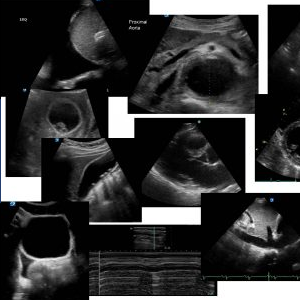
Images by Genevieve Carbonatto
Parasternal long axis view, (PLAX) of the left ventricle showing bileaflet mitral valve prolapse, (MVP) but much more prominent in the posterior leaflet. The PLAX is the best window to use to diagnose MVP.
Parasternal long axis view, (PLAX) of the left ventricle showing bileaflet mitral valve prolapse.
- The posterior MV prolapse is more prominent than the anterior mitra valve valve leaflet prolapse.
- Note that there are two mitral regurgitant jets.
- The posterior MVP causes an anteriorly directed MR jet .
- The second MR jet is more centrally directed.
Parasternal short axis at the level of the mitral valve leaflet tips.
Parasternal short axis at the level of the mitral valve leaflet with colour across the valve.
Parasternal short axis at the level of the left ventricular outflow tract demonstrating mainly the anterior mitral valve leaflet with a significant amount of redundant tissue. The posterior leaflet is not well seen at this level.
Apical 4-chamber view with colour across the mitral valve. The anterior direction of the jet is displayed. To assess the full length and direction of the anteriorly directed jet, the colour box should be opened a little more in both width and length. We need to visualise the flow convergence zone of the jet and its full length to the pulmonary veins.





